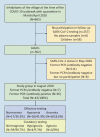High prevalence of long-term olfactory dysfunction confirmed by olfactory testing after a community COVID-19 outbreak
- PMID: 34940903
- PMCID: PMC8697538
- DOI: 10.1007/s00106-021-01129-7
High prevalence of long-term olfactory dysfunction confirmed by olfactory testing after a community COVID-19 outbreak
Abstract
Purpose: The prevalence of long-term olfactory and gustatory dysfunction in participants suffering from sudden chemosensory loss due to coronavirus disease 2019 (COVID-19) is unknown. Furthermore, evaluations of the reliability of participants' self-reporting of olfactory function (SOF) and gustatory function (SGF) using extended objective psychophysical testing are missing.
Methods: In this population-based cohort study in a PCR-tested community in Thuringia, Germany, olfactory function was extensively examined 4 months after a COVID-19 outbreak using the "Sniffin Sticks" test battery to determine the TDIa score, i.e., the sum of results obtained for threshold, discrimination, and identification scores averaged for both nasal sides. Gustatory function was assessed using the three-drop test resulting in the gustatory composite score (CSg). The data were compared with SOF and SGF.
Results: Of 43 adult convalescents (median age: 68 years; 58% female) after SARS-CoV‑2 infection, 18 participants (42%) had olfactory complaints due to SOF, one participant (2%) complained of taste disturbance due to SGF. The TDIa was 22.0 ± 5.9. Normosmia, hyposmia, and anosmia were seen in 17, 18, and eight participants, respectively. TDIa correlated with SOF (rs = -0.434, p = 0.004); CSg was 23.5 ± 2.7. Normogeusia and hypogeusia were objectified in 39 and four participants, respectively. The prevalence of long-term olfactory dysfunction and gustatory dysfunction in the study group was 60.5 and 9.3%, respectively.
Conclusion: The SOF was reliable, especially for participants who felt a sudden chemosensory dysfunction during the outbreak. At 4 months after SARS-CoV‑2 infection, a high proportion of participants were dysosmic, whereas nearly all of them had normal taste function.
Zusammenfassung: ZIEL: Die Prävalenz einer langfristigen olfaktorischen und gustatorischen Dysfunktion bei Patienten, die initial aufgrund der Coronavirus-Krankheit 2019 (COVID-19) einen plötzlichen chemosensorischen Verlust erlitten haben, ist unbekannt. Darüber hinaus fehlen Auswertungen zur Zuverlässigkeit der Selbstauskunft der Patienten zur Geruchsfunktion (SOF) und zur Schmeckfunktion (SGF) mittels erweiterter psychophysischer Tests.
Methoden: In dieser populationsbasierten Kohortenstudie in einer PCR-getesteten Gemeinde in Thüringen wurde die Riechfunktion 4 Monate nach einem COVID-19-Ausbruch standardisiert mit „Sniffin-Sticks-Testbatterien“ zur Bestimmung des TDIa-Scores getestet, d. h. die Summe der Ergebnisse, die für Schwellenwert‑, Diskriminierungs- und Identifizierungstest erhalten wurden, gemittelt für beide Nasenseiten. Die gustatorische Funktion wurde mit dem 3‑Tropfen-Test getestet, der einen Gustatory Composite Score (CSg) ergab. Die Daten wurden mit SOF und SGF verglichen.
Ergebnisse: Von 43 erwachsenen Rekonvaleszenten (mittleres Alter: 68 Jahre; 58 % weiblich) mit SARS-CoV-2-Infektion berichteten 18 Teilnehmer (42 %) über eine anhaltende Geruchsminderung im SOF, ein Teilnehmer (2 %) klagte über eine Schmeckstörung im SGF. TDIa betrug 22,0 ± 5,9. Normosmie, Hyposmie und Anosmie wurden bei 17, 18 bzw. 8 Patienten beobachtet. TDIa korrelierte mit SOF (rs = −0,434; p = 0,004). CSg betrug 23,5 ± 2,7. Normogeusie und Hypogeusie wurden bei 39 bzw. 4 Patienten objektiviert. Die Prävalenz langfristiger Riech- und Geschmacksstörungen in der Studiengruppe betrug 60,5 bzw. 9,3 %.
Schlussfolgerungen: Der SOF erwies sich als besonders zuverlässig geeignet für Patienten, die während des Ausbruchs eine plötzliche chemosensorische Dysfunktion bemerkt haben. Ein hoher Anteil der Teilnehmer war 4 Monate nach der SARS-CoV-2-Infektion immer noch dysosmisch, während fast alle eine normale Schmeckfunktion aufwiesen.
Keywords: Coronavirus; Long-term sequelae; Olfaction; Outbreak; Smell.
© 2021. The Author(s).
Conflict of interest statement
H. Gudziol, T. Kirschstein, M.W. Pletz, S. Weis, O. Guntinas-Lichius and T. Bitter declare that they have no competing interests.
Figures
References
-
- Lechien JR, Chiesa-Estomba CM, De Siati DR, et al. Olfactory and gustatory dysfunctions as a clinical presentation of mild-to-moderate forms of the coronavirus disease (COVID-19): a multicenter European study. Eur Arch Otorhinolaryngol. 2020;277(8):2251–2261. doi: 10.1007/s00405-020-05965-1. - DOI - PMC - PubMed
-
- Borsetto D, Hopkins C, Philips V, et al. Self-reported alteration of sense of smell or taste in participants with COVID-19: a systematic review and meta-analysis on 3563 participants. Rhinology. 2020;58(5):430–436. - PubMed
MeSH terms
LinkOut - more resources
Full Text Sources
Medical
Miscellaneous



